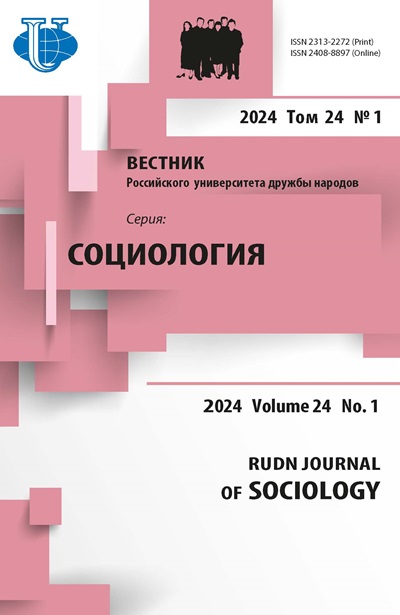On the reasons of radical forms of social protest: Reflections about principles of ‘Malthusian trap’ and demographic factors
- Authors: Shults EE1
-
Affiliations:
- Center for Political and Social Technologies
- Issue: Vol 17, No 2 (2017)
- Pages: 180-191
- Section: Theory, Methodology and History of Sociological Research
- URL: https://journals.rudn.ru/sociology/article/view/15915
- DOI: https://doi.org/10.22363/2313-2272-2017-17-2-180-191
Cite item
Full Text
Abstract
The article considers reasons for radical mass forms of social protest in the context of the ‘Malthusian trap’ and structural-demographic theory of Jack Goldstone, which have become popular in the last two decades. The author critically evaluates these two conceptions and comes to the conclusion that the principles they underline are just concomitant factors, i.e. additional risk factors for political systems and regimes, rather than causes of radical mass forms of social protest. The author suggests a method of analysis that consists of studying the circumstances, i.e. the wide historical context, in which mass forms of social protest usually emerge, and provides a large number of illustrative examples. The scientific approach to the identification of social-historical determinants of radical forms of social protest implies that if something is a reason/cause of an event, then this reason/cause must be present whenever there is such an event both alone or within a complex of concomitant factors. The ‘Malthusian trap’ and demographic factors cannot be traced in all manifestations of radical mass forms of social protest in modern and contemporary history. Moreover, the ‘Malthusian trap’ and demographic pressure on the economy and social system do not always lead to mass forms of social protest. The wave of radical forms of social protest in the last decade, i.e. the so-called ‘color revolutions’, ‘Arab spring’, protest actions in France, England and the USA, once again confirms the relevance of the author’s approach and the importance of critical study of the traditional conceptions.
About the authors
E E Shults
Center for Political and Social Technologies
Author for correspondence.
Email: nuap1@yandex.ru
B. Filevskaya St., 55-1, Moscow, Russia, 121433
References
- Grinin L.E. Mal'tuziansko-marksova «lovushka» i russkie revoljucii [Malthusian-Marx trap and Russian revolutions]. O prichinah russkoj revoljucii. Moscow: Izdatel'stvo LKI; 2010: 198—224 (In Russ).
- Grinin L.E., Malkov S.Ju., Gusev V.A., Korotaev A.V. Nekotorye vozmozhnye napravlenija razvitija teorii social'no-demograficheskih ciklov i matematicheskie modeli vyhoda iz mal'tuzianskoj lovushki [Some possible directions in the development of the theory of social-demographic cycles, and mathematical models for getting out of the Malthusian trap]. Istorija i matematika: processy i modeli / Red. S.Ju. Malkov, L.E. Grinin, A.V. Korotaev. Moscow: LIBROKOM; 2009: 134—210 (In Russ).
- Clark G. Proshhaj, nishheta! Kratkaja ekonomicheskaja istorija mira [A Farewell to Alms: a Brief Economic History of the World]. Moscow: Izdatel'stvo Instituta Gajdara; 2012 (In Russ).
- Korotaev A.V. Social'naja evoljucija: faktory, zakonomernosti, tendencii [Social Evolution: Factors, Regularities, Tendencies]. Moscow: “Vostochnaja literature” RAN; 2003 (In Russ).
- Livi Bachi M. Demograficheskaja istorija Evropy [Demographic History of Europe]. Saint Petersburg: Aleksandrija; 2010 (In Russ).
- Malthus T.-R. An Essay on the Principle of Population. Moscow: Izdanie K.T. Soldatenkova, Tipo-litografija O.I. Lashvevich i Ko; 1895. (In Russ).
- Milov L.V. Velikorusskij pahar' i osobennosti rossijskogo istoricheskogo processa [Great Russian Plowman, and Features of the Russian Historical Process]. Moscow: ROSSPEN; 1998 (In Russ).
- Tocqueville A. Staryj porjadok i revoljucija. [Old Regime and Revolution]. Saint Petersburg: Aletejja; 2008 (In Russ).
- Chekantseva Z.A. Porjadok i besporjadok: protestujushhaja tolpa vo Francii mezhdu Frondoj i revoljuciej. [Order and Disorder: Protesting Crowd in France between Opposition and Revolution]. Moscow: LIBROKOM; 2012 (In Russ).
- Shults E.E. Prihod nacistov k vlasti v Germanii i koncepcija «molodezhnogo bugra» [Coming of Nazis to power in Germany, and the concept of “youth bulge”]. Obshhestvo. Sreda. Razvitie, 2015;3:98—101 (In Russ).
- Shults E.E. Prichiny vozniknovenija radikal'nyh form social'nogo protesta (istoriograficheskij obzor) [Origins of radical forms of social protest: A historiographical review]. Vestnik MGU. Serija “Politologija”, 2014;2:39—49 (In Russ).
- Shults E.E. Prichiny revoljucij: golova ili koshelek? [Reasons of revolutions: Life or purse?]. Istoricheskaja psihologija i sociologija istorii, 2014;1:102—119 (In Russ).
- Shults E.E. Problemnye voprosy social'noj bazy NSDAP: k prichinam uspeha nacistov na vyborah 1928—33 gg. [The social base of NSDAP: Reasons for Nazis success in 1928—1933 elections]. RUDN Journal of Sociology, 2015;1:42—53 (In Russ).
- Shults E.E. Teorija revoljucii: revoljucii i sovremennye civilizacii [Theory of Revolution: Revolutions and Modern Civilizations]. Moscow: LENAND; 2016.
- Shults E.E. Fenomen kubinskoj revoljucii v kontekste tehnologij upravlenija social'nym protestom [A phenomenon of the Cuban revolution in the context of technologies for managing social protest]. Privolzhskij nauchnyj vestnik, 2014;4:145—153 (In Russ).
- Abel W. Agrarkrisen und Agrarkonjunktur. Mitteleuropa vom 13. bis zum 19. Jahrhundert. Berlin; 1935.
- Abel W. Bevölkerungsgang und Landwirtschaft im ausgehenden Mittelalter im Lichte der Preis- und Lohnbewegung. Schmollers Jahrbücher. 1934. No. 58.
- Bonar J. Malthus and His Work. L.: Macmillan & Co.; 1885.
- Crouzet F. A History of the European Economy, 1000—2000. Charlottesville—L.: The University Press of Virginia; 2001.
- Goldstone J.A. Population and security: How demographic change can lead to violent vonflict. Journal of International Affairs, 2002;56:3—21.
- Goldstone J.A. Revolution and Rebellion in the Early Modern World. Berkeley: University of California Press; 1991.
- Goldstone J.A. The new population bomb: The four megatrends that will change the world. Foreign Affairs, 2010:89(1):31—43.
- Turchin P., Korotayev A. Population dynamics and internal warfare: A reconsideration. Social Evolution & History, 2006;5:112—147.














